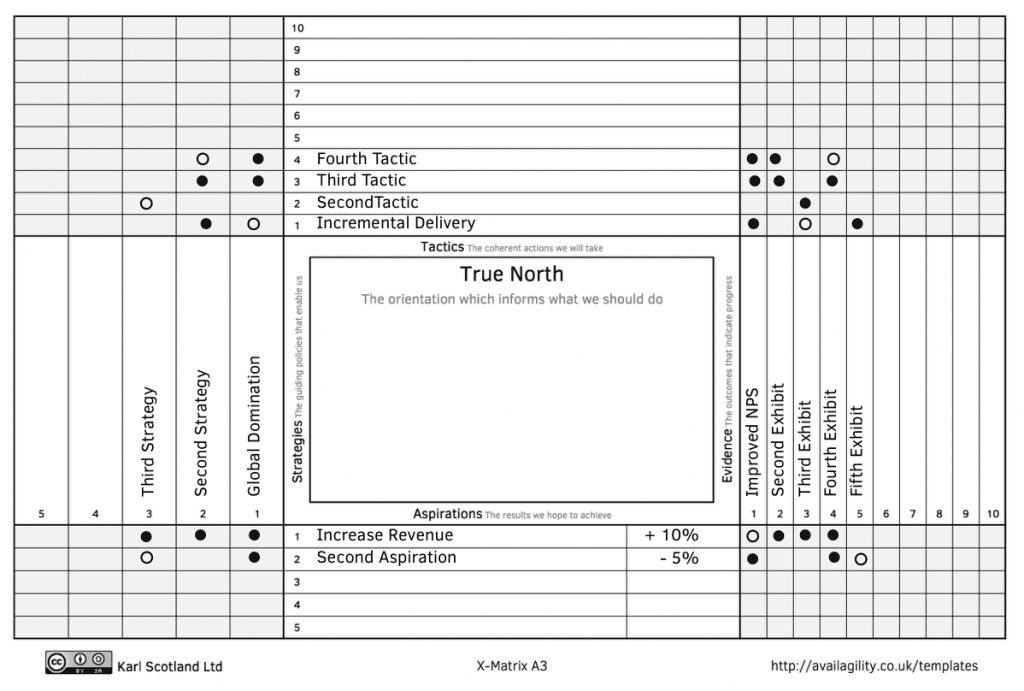I promised to say more about correlations in my last post on how to TASTE Success with the X-Matrix .
One of the things I like about the X-Matrix is that it allows clarity of alignment, without relying on an overly analytical structure. Rather than consisting of simple hierarchical parent-child relationships, it allows more elaborate many-to-many relationships of varying types. This creates a messy coherence – everything fits together, but without too much neatness or precision.
This works through the shaded matrices in the corners of the X-Matrix – the ones that together form an X and give this A3 its name! Each cell in the matrices represents a correlation between two of the numbered elements. Its important to emphasise that we are representing correlation, and not causation. There may be a contribution of one to the other, but it is unlikely to be exclusive or immediate. Thus implementing Tactics collectively contribute towards applying Strategies and exhibiting Evidence. Similarly applying Strategies and exhibiting Evidence both collectively contribute towards meeting Aspirations. What we are looking for is a messy coherence across all the pieces.
There are a few approaches I have used to describe different types of correlation.
- Directness – Can a direct correlation be explained, or is the correlation indirect via another factor (i.e. it is oblique). This tends to be easier to be objective about.
- Strength – Is there a strong correlation between the elements, or is the correlation weak. This tends to be harder to describe because strong and weak are more subjective.
- Likelihood – Is the correlation probable, possible or plausible. This adds a third option, and therefore another level of complexity, but the language can be useful.
Whatever the language, there is always the option of none. An X-Matrix where everything correlates with everything is usually too convenient and can be a sign of post-hoc justification.
Having decided on an approach, a symbol is used in each cell to visualise the nature of each correlation. I have tried letters and colours, and have recently settled on filled and empty circles, as in the example below. Filled circles represent direct or strong correlations, while empty circles represent indirect or weak correlations. (If using likelihood, a third variant would be needed, such as a circle with a dot in the middle).
Here we can see that there is a direct or strong correlation between “Increase Revenue +10%” (Aspiration 1) and “Global Domination” (Strategy 1). In other words this suggests that Strategy 1 contributes directly or strongly to Aspiration 1. As do all the Strategies, which indicates high coherence. Similarly, Strategy 1 has a direct/strong correlation with Aspiration 2, but Strategy 2 has no correlation, and Strategy 3 only has indirect/weak correlation.
Remember, this is just a hypothesis, and by looking at the patterns of correlations around the X-Matrix we can see and discuss the overall coherence. For example we might question why Strategy 3 only has Tactic 2 with an indirect/weak correlation. Or whether Tactic 2 is the best investment given its relatively poor correlations with both Strategies and Evidence. Or whether Evidence 4 is relevant given its relatively poor correlations with both Tactics and Aspiration.
Its visualising and discussing these correlations that is often where the magic happens, as it exposes differences in understandings and perspectives on what all the pieces mean and how relate to each other. This leads to refinement of X-Matrix, more coherence and stronger alignment.


